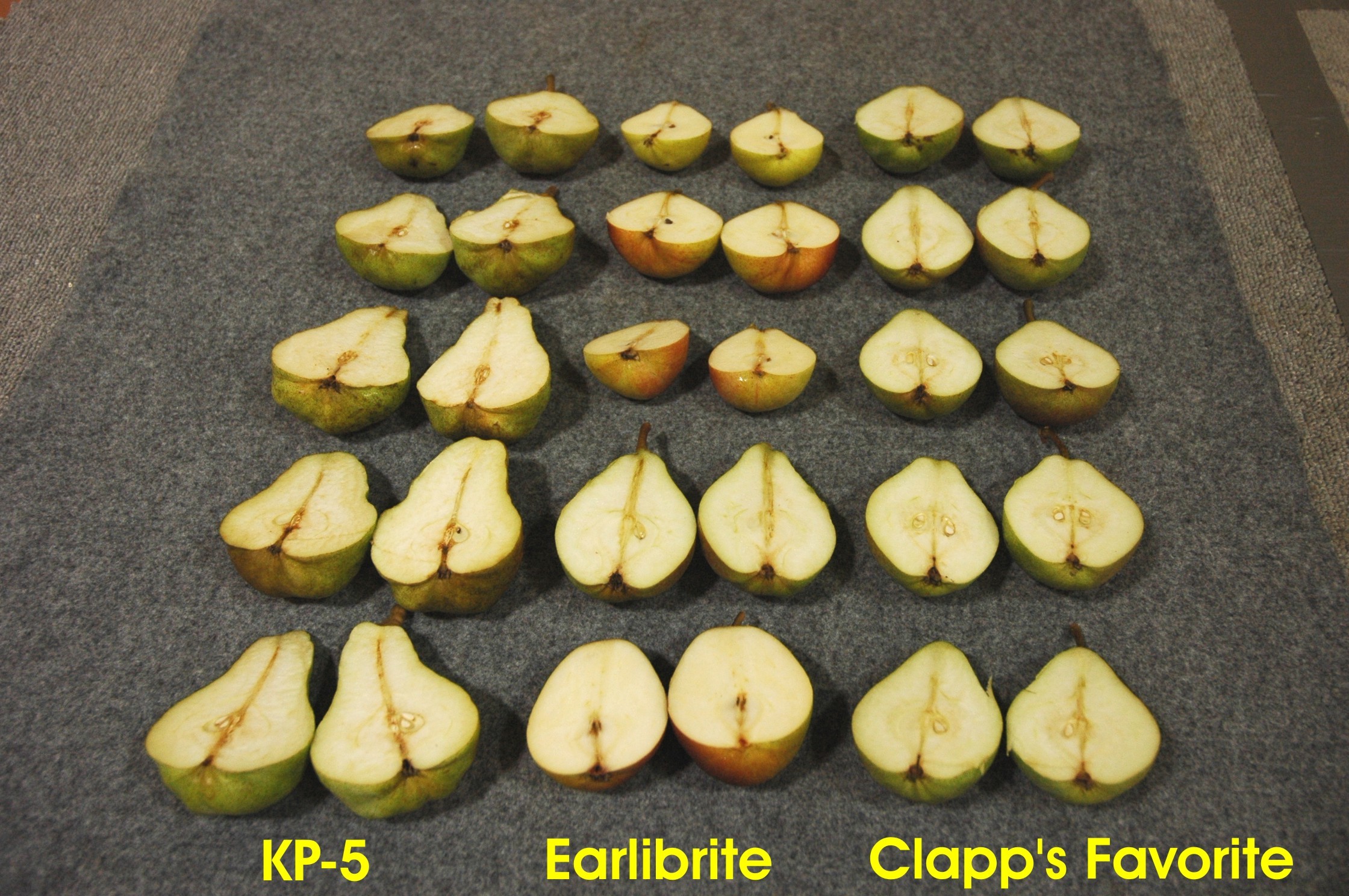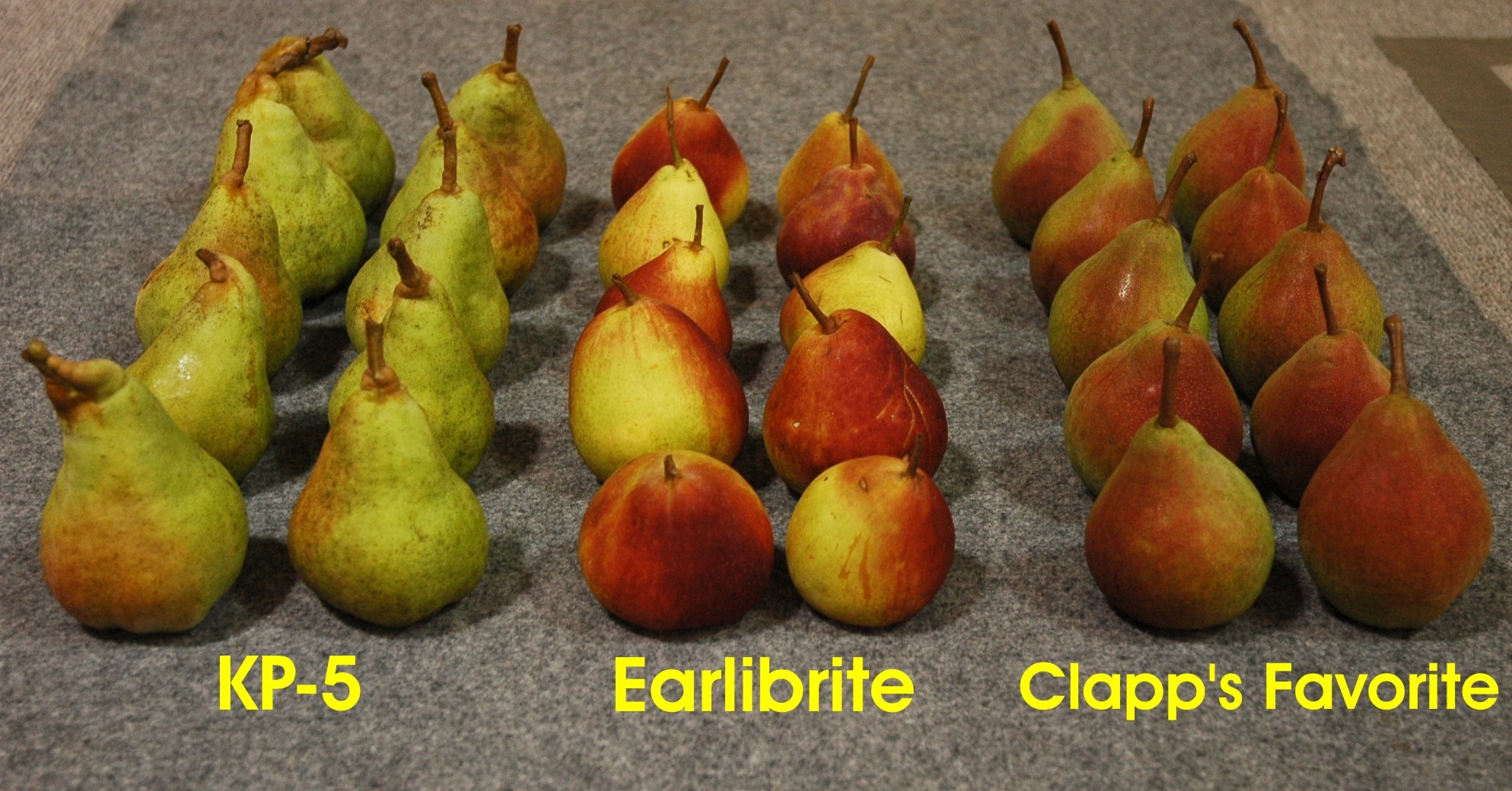KP5
| Denomination: | 'KP5' |
|---|---|
| Previously Proposed Denomination: | 'Little Elephant' |
| Botanical Name: | Pyrus communis |
| Applicant/Holder: |
Agriculture & Agri-Food Canada, Kentville Atlantic Food & Horticulture Research Centre 32 Main Street Kentville, Nova Scotia B4N 1J5 Canada |
| Breeder: |
Charles G. Embree, Agriculture & Agri-Food Canada, Kentville, Nova Scotia |
| Agent in Canada: |
Agriculture & Agri-Food Canada Office of Intellectual Property and Commercialization c/o Shannon Whyte 107 Science Place Saskatoon, Saskatchewan S7N 0X2 Canada Tel: (204) 999-9887 |
| Application Date: | 2008-05-01 |
| Application Number: | 08-6324 |
| Grant of Rights Date: | 2011-12-02 |
| Certificate Number: | 4223 |
| Grant of Rights Termination Date: | 2029-12-02 |
Variety Description
Varieties used for comparison: 'Earlibrite' and 'Clapp's Favourite'
Summary: 'Little Elephant' has strong branching while it is medium in the reference varieties. The internode length on the one year old shoots is long in 'Little Elephant' while it is medium length in the reference varieties. 'Little Elephant' has a small leaf blade length/width ratio while it is medium in the reference varieties. The curvature of the longitudinal axis of the leaf blade is strong in 'Little Elephant' while it is medium in the reference varieties. 'Little Elephant' begins flowering later in the season than 'Earlibrite'. The sepal of 'Little Elephant' is long while it is short in 'Earlibrite' and medium length in 'Clapp's Favourite'. 'Little Elephant' has a large flower petal while it is medium sized in 'Clapp's Favourite'. The fruit of 'Little Elephant' is long while it is short in 'Earlibrite' and medium length in 'Clapp's Favourite'. 'Little Elephant' has a medium to large sized fruit while it is small in the reference varieties. 'Little Elephant' has a smaller amount of red overcolour on the fruit than the reference varieties. The area of russet around the stalk cavity of the fruit of 'Little Elephant' is greater than in the reference varieties. 'Little Elephant' has a thicker fruit stalk than 'Earlibrite'. The time of maturity for consumption in 'Little Elephant' is later than the reference varieties.
Description:
TREE: medium vigour, strong branching, semi-upright habit, beginning of flowering is mid season, time of maturity for consumption is medium
ONE YEAR OLD SHOOTS: wavy growth, long internode, orange brown colour on sunny side, many lenticels
VEGETATIVE BUD: acute apex, in relation to the shoot is slightly held out, medium sized bud support
YOUNG SHOOTS: weak anthocyanin colouration of growing tip, sparse pubescence on upper third
LEAF: outwards attitude in relation to shoot, small length/width ratio, truncate base, acute to right angled apex, medium length of pointed tip, crenate margin, shallow incisions, strong curvature of longitudinal axis
PETIOLE: long, stipules present, short distance of stipules from basal attachment
FLOWER: bud mainly on spurs, medium length bud, stigma at the same level as stamens
SEPALS: long, recurved in relation to corolla, erect at harvest
PETALS: touching, large, circular, rounded base, short claw
FRUIT: green brown sepals on immature fruit, long, maximum diameter medium, medium length/diameter ratio, position of maximum diameter is slightly to clearly towards the calyx, medium to large size, symmetric in longitudinal cross section, concave profile to sides, absent to very small area of russet on cheeks
SKIN: green ground colour, very small to small amount of light to dark red over colour
STALK: thick, medium to strong curvature, oblique attitude in relation to axis of the fruit, stalk cavity absent, large area of russet around stalk attachment
EYE BASIN: shallow, medium width at harvest, embossed relief of area around at harvest, small to medium area of russet around
FLESH: medium texture, medium firmness, juicy
SEED: elliptic
Origin & Breeding History: 'Little Elephant' (experimental designations KP-5 , S22-44-04) was developed at the Agriculture & Agri-Food Research Station in Kentville, Nova Scotia. The initial cross was made by Dr. A. D. Crowe and Doug Crouse in 1970 between the cultivars 'Beiershmit' and 'Comice'. The selected seedlings were grafted on 'Bartlett' rootstocks for further evaluation. The selection criteria included fruit size, fruit quality and time of maturity.
Tests & Trials: Tests and trials were conducted in 2008 at the Agriculture & Agri-Food Horticulture Research Center in Kentville, Nova Scotia. There were 6 trees of 'Little Elephant' and 'Clapp's Favourite' and 5 trees of 'Earlibrite' in trial. The trial was planted in 1996 with a RCB design, with trees spaced 3 meters apart within the row and rows spaced 4.75 meters apart.
Comparison table for 'KP5' with reference varieties 'Earlibrite' and 'Clapp's Favourite'
Fruit length (mm)
| 'KP5' | 'Earlibrite' | 'Clapp's Favourite' | |
|---|---|---|---|
| mean | 90.677 | 78.207 | 84.611 |
| std. deviation | 7.277 | 5.781 | 4.255 |
Click on image for larger view

Pear: 'Little Elephant' (left) with reference varieties 'Earlibrite' (centre) and 'Clapp's Favorite' (right)
Click on image for larger view

Pear: 'Little Elephant' (left) with reference varieties 'Earlibrite' (centre) and 'Clapp's Favorite' (right)
- Date modified: